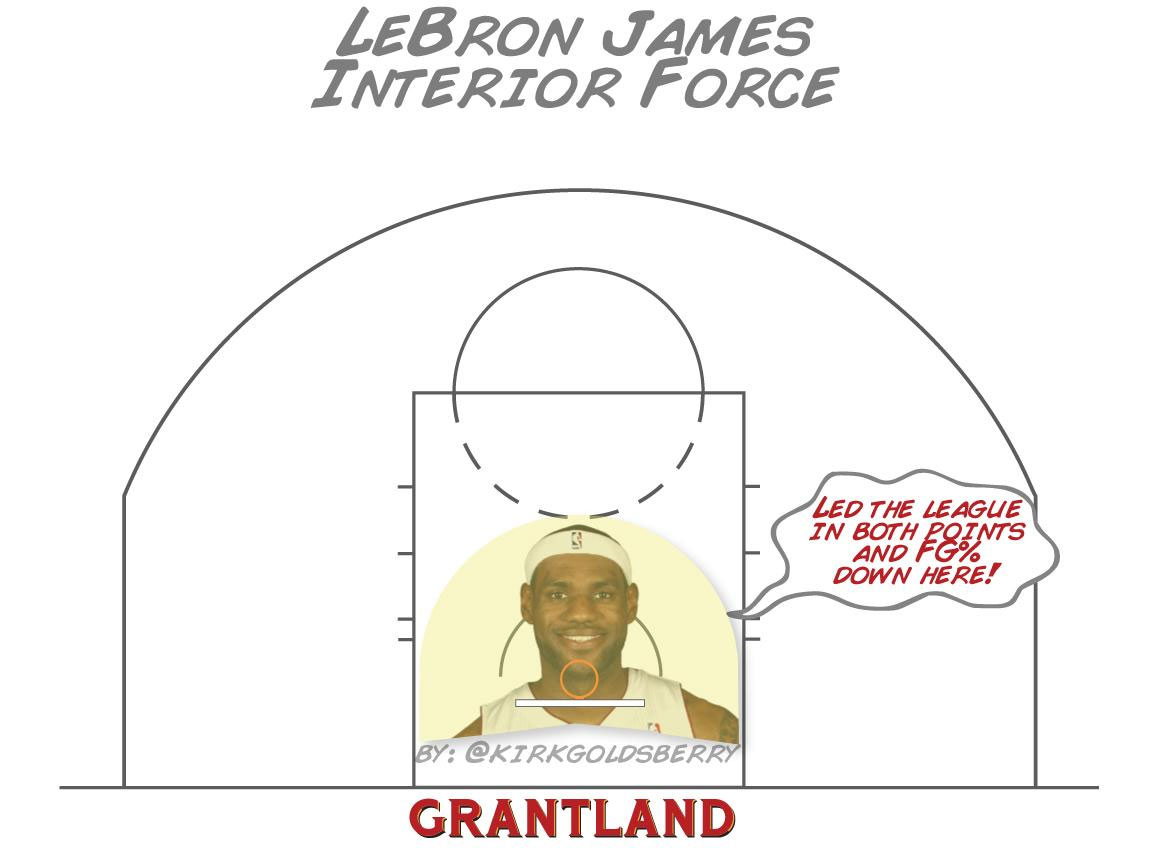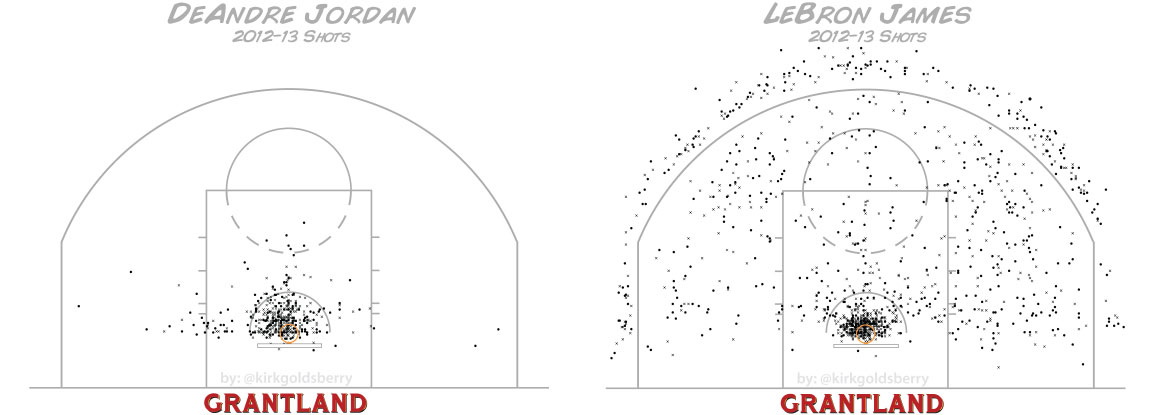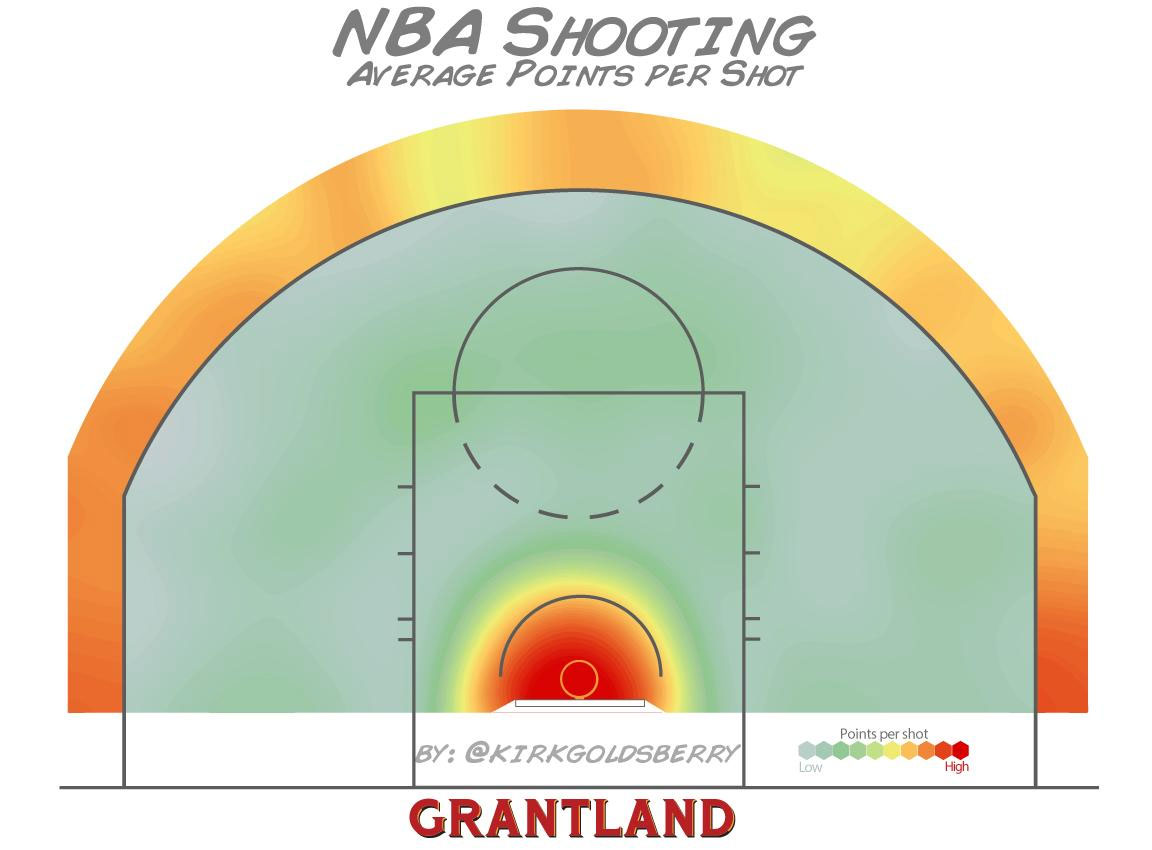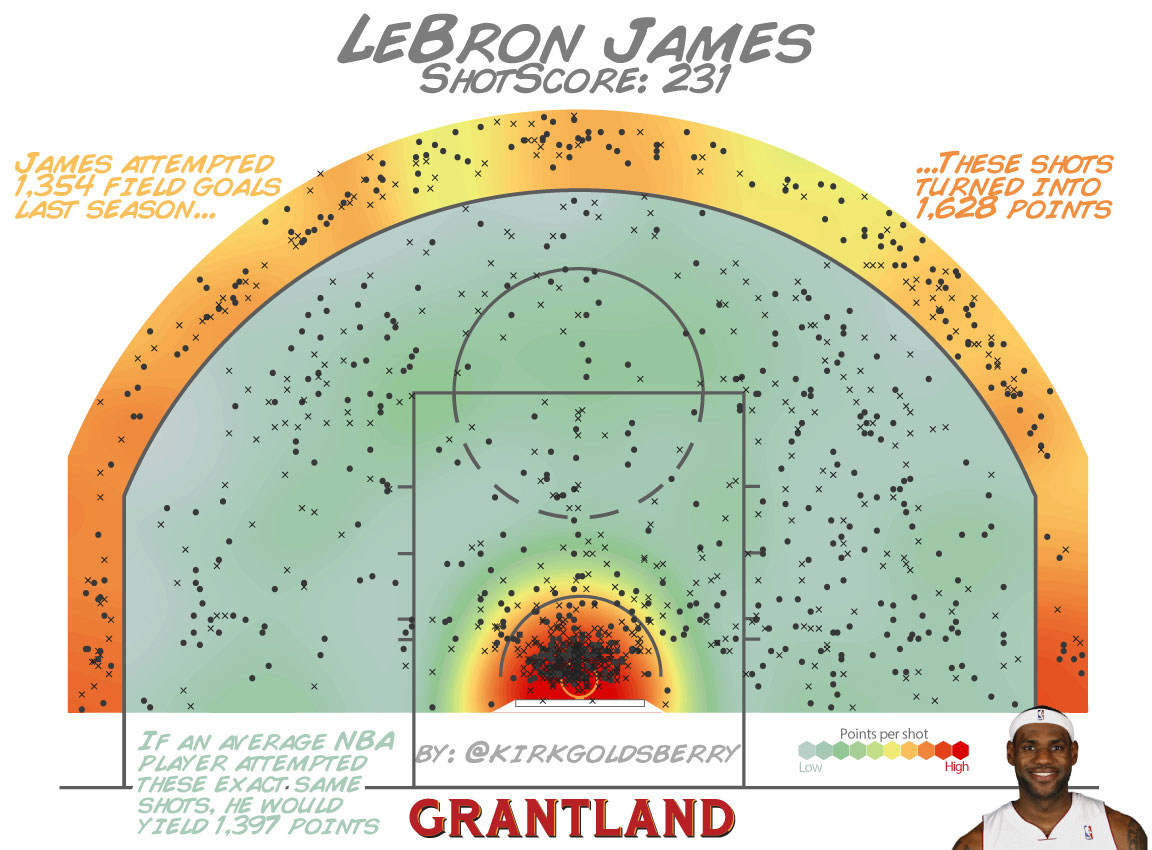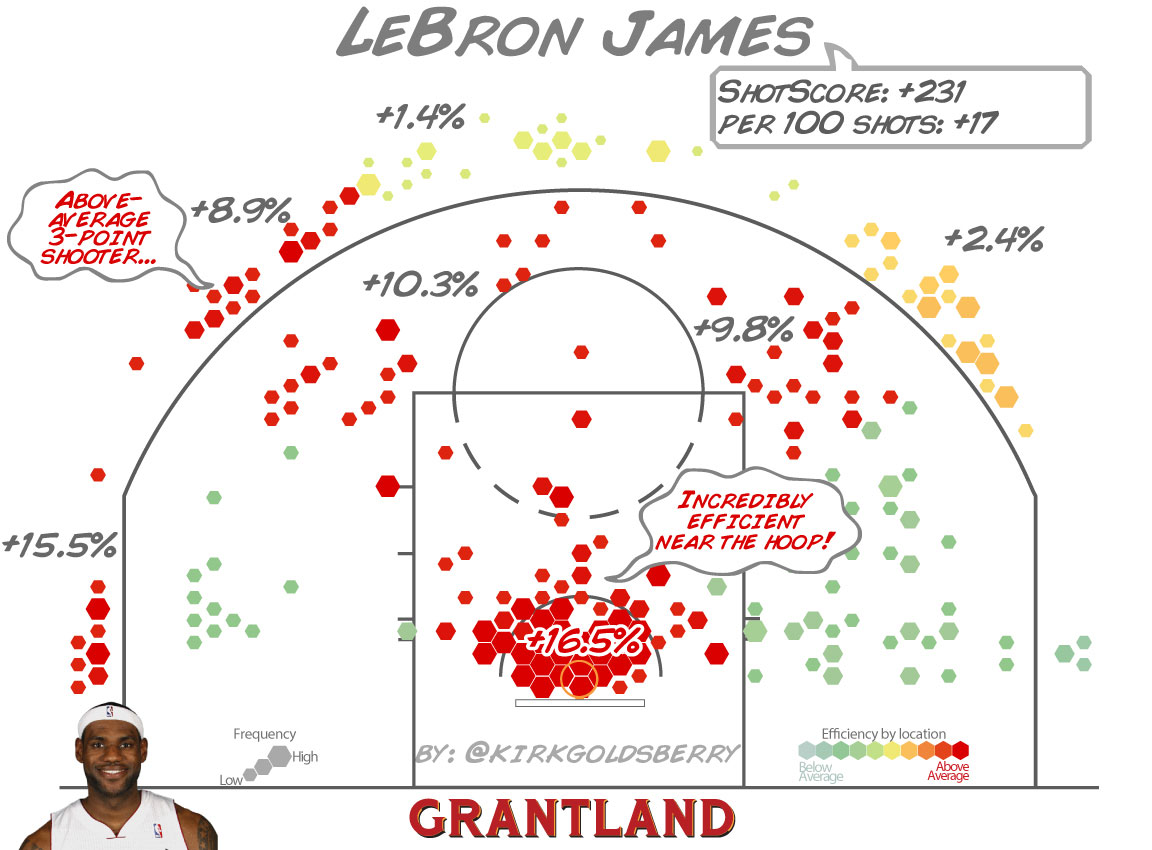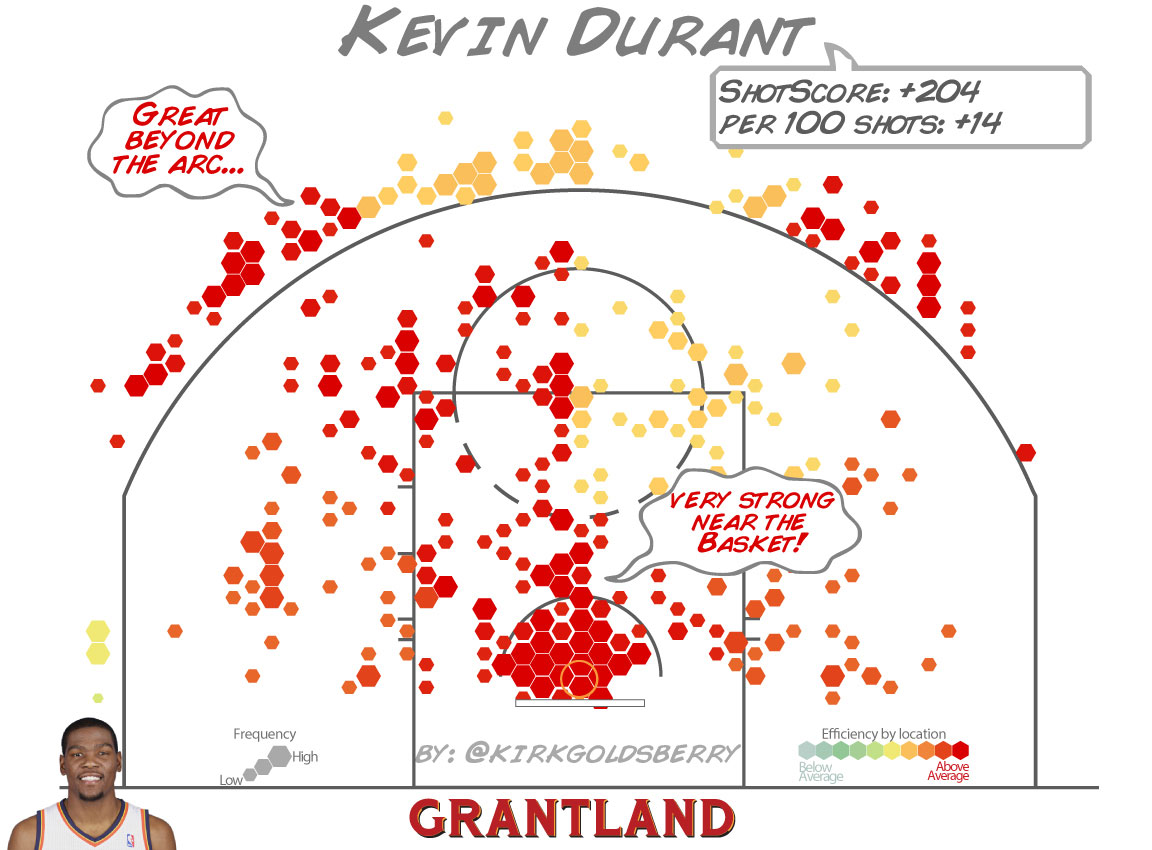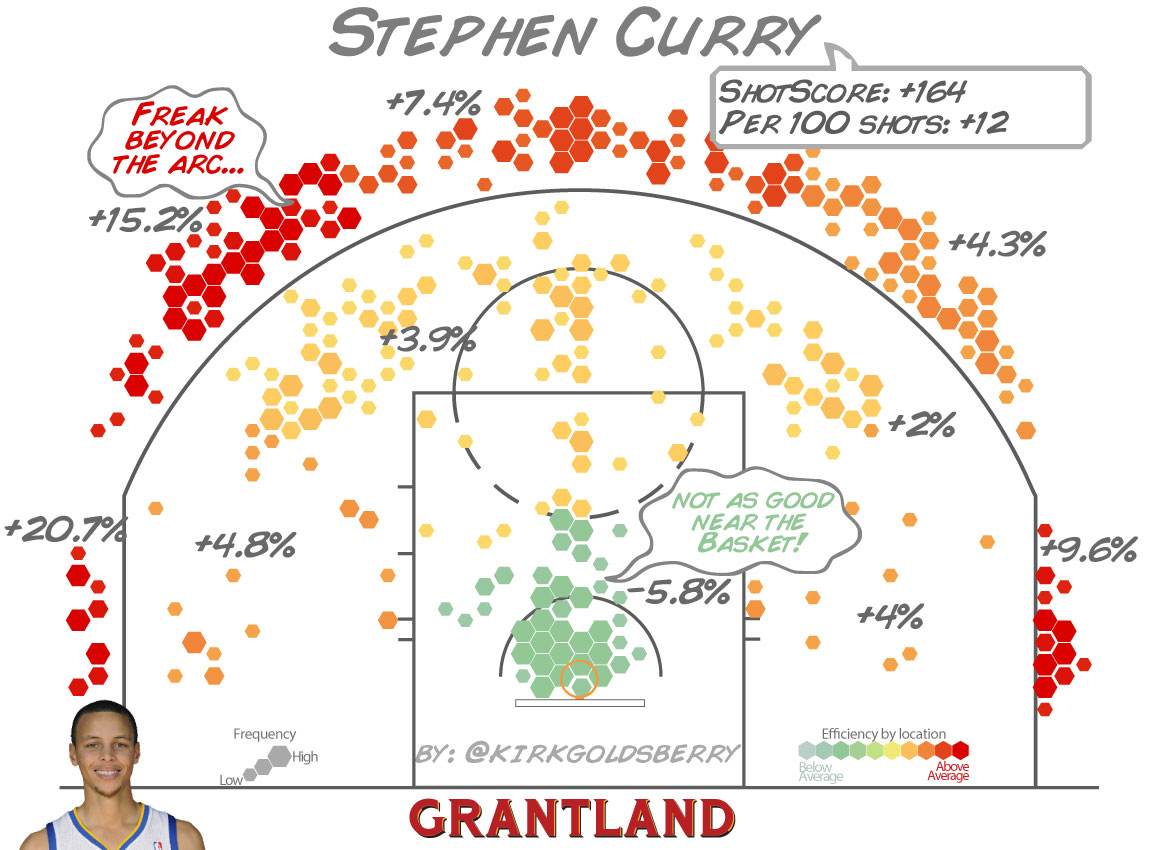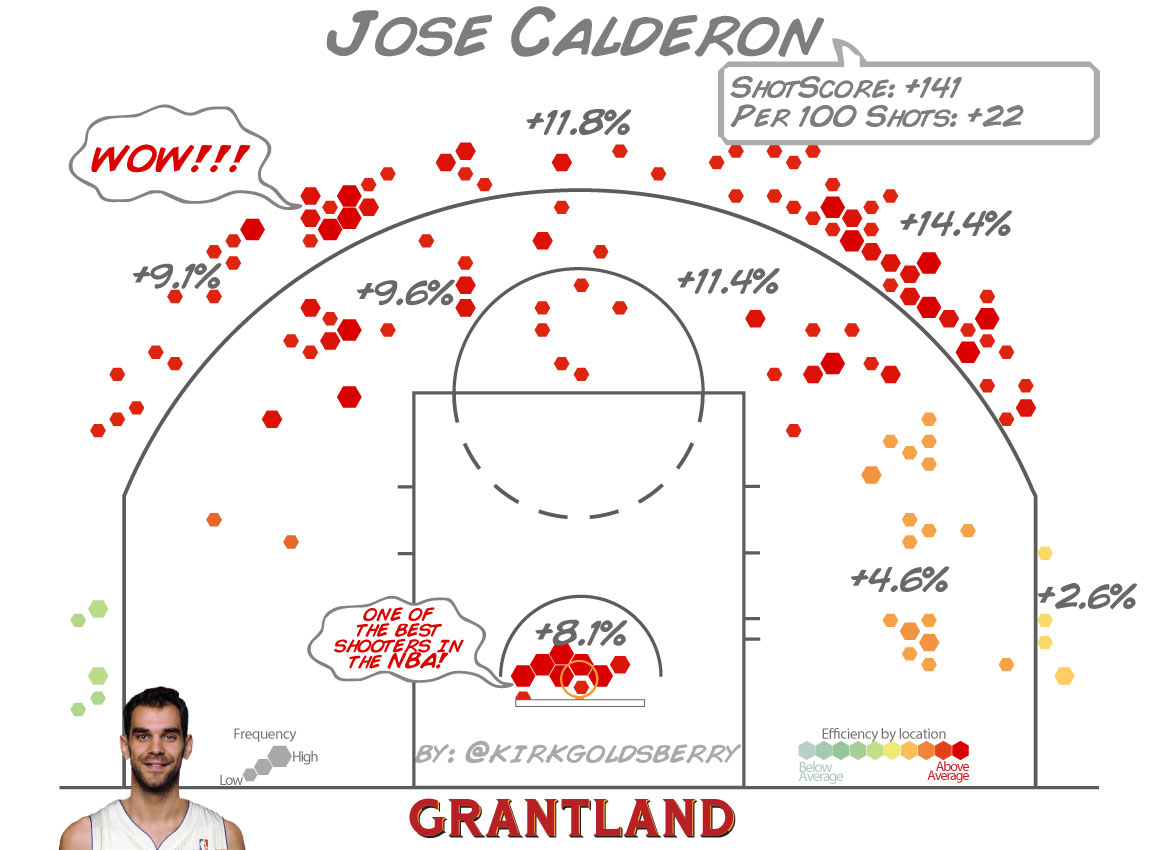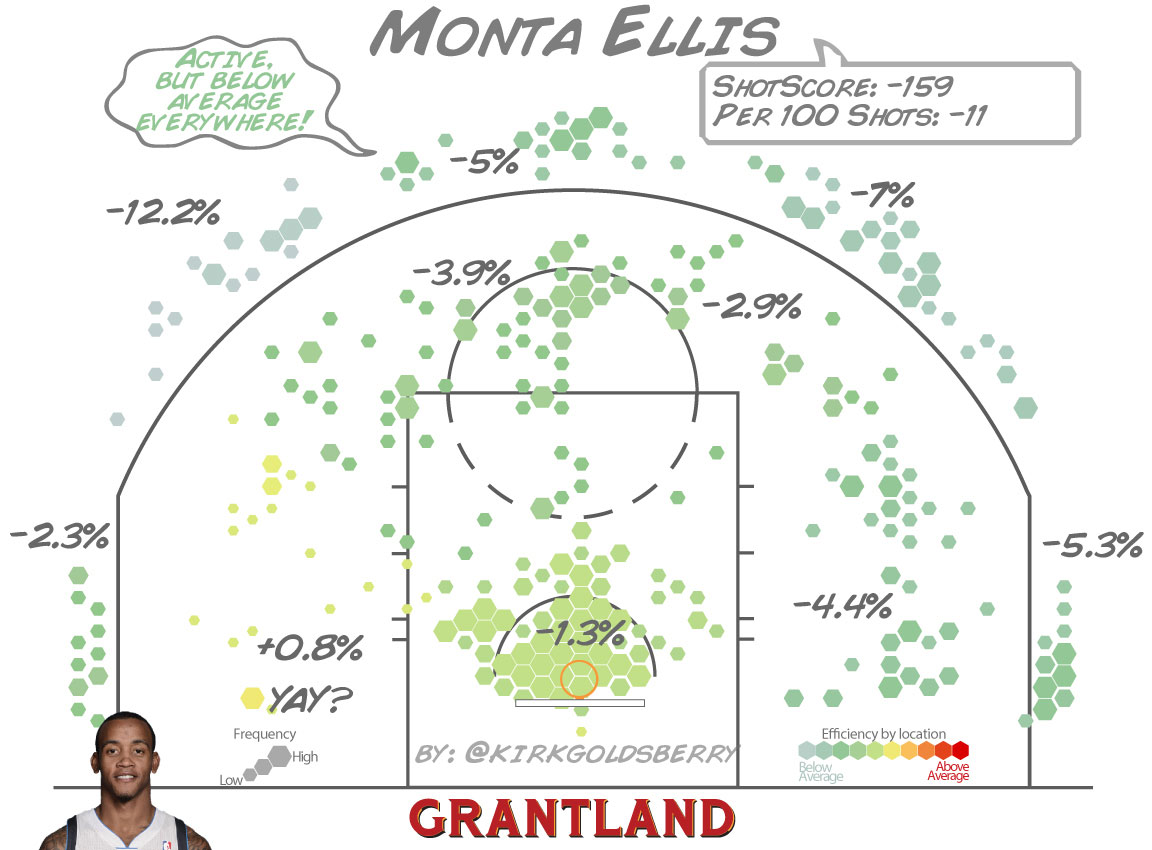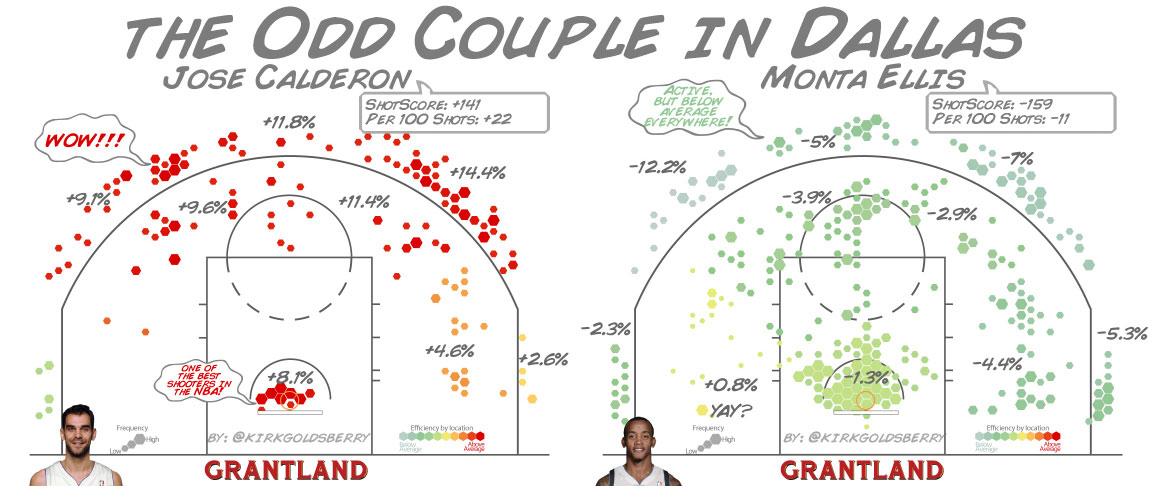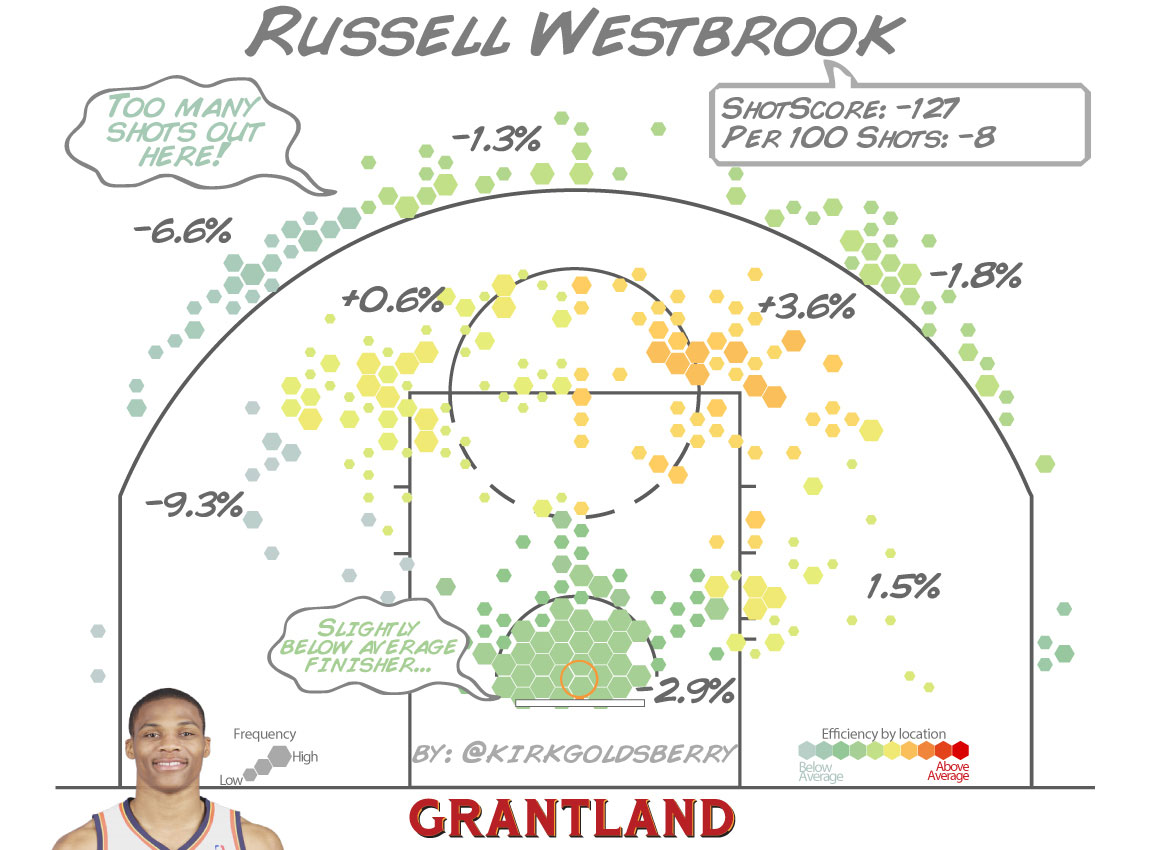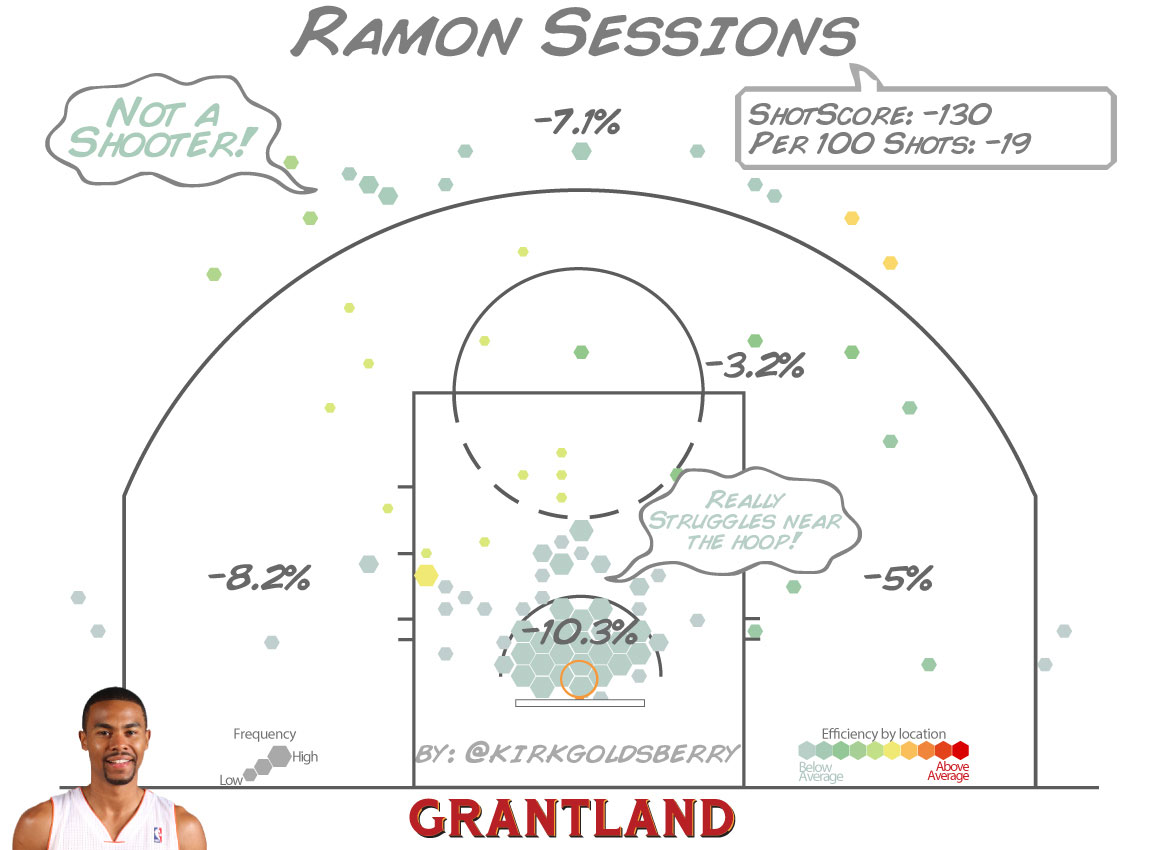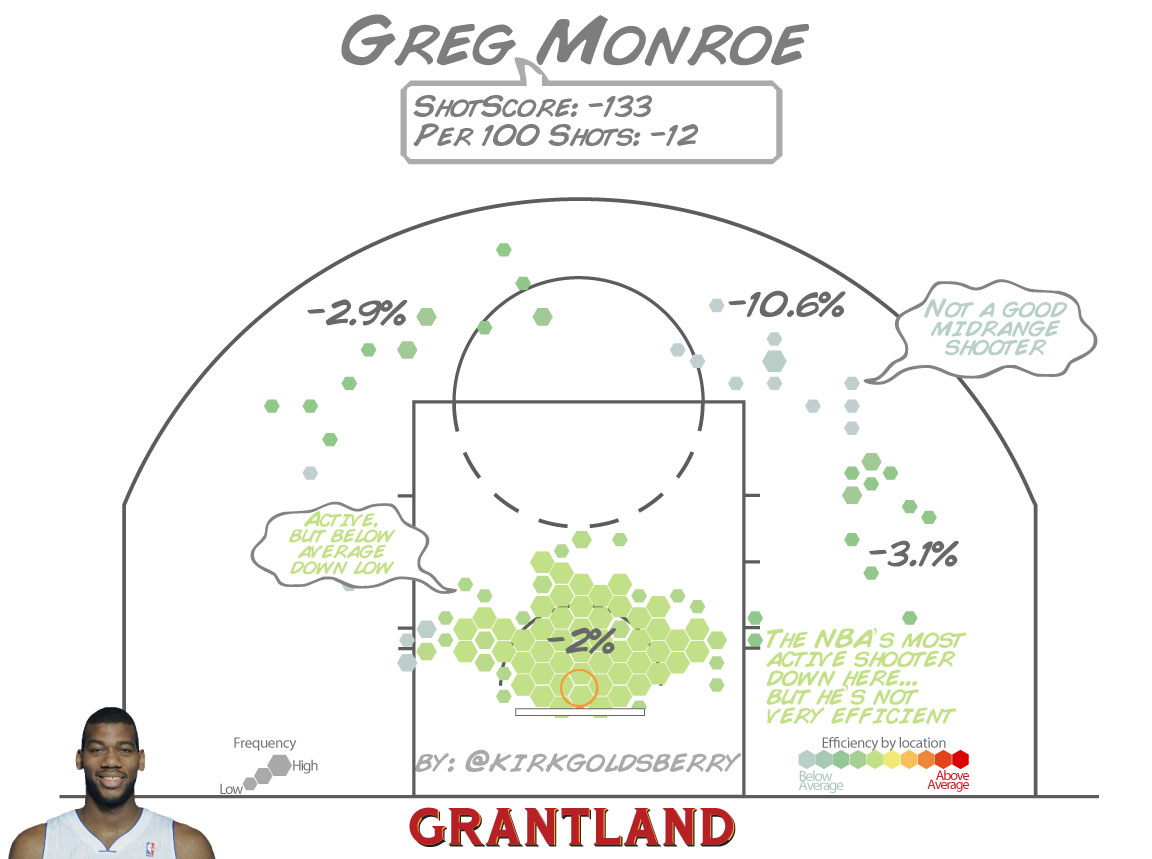- 85,829
- 112,263
- Joined
- Sep 5, 2010
Extra Points
A new way to understand the NBA's best scorers
LeBron James is the best player in the world. That may be obvious to anyone who has watched basketball over the past few years, but for some reason it's hard to find many statistics to support this claim. Back when Michael Jordan ruled the NBA, he would commonly lead the league in points per game; Chamberlain and Russell put up insane rebounding numbers; Kareem Abdul-Jabbar is the league's all-time leading scorer.
James recently joined those giants as one of the five NBA players to win four MVP awards. Despite that impressive feat, his dominance is not reflected in conventional basketball stats. Somehow a vast majority of the game's most oft-cited statistics obscure the greatness of the game's greatest player. James shines in terms of Win Shares and PER, but those stats only vaguely describe what makes him so good. They fail to highlight any particular element of James's performance. In fact, many of our most common metrics imply that other players are more effective or more efficient than James.
Last season, DeAndre Jordan led the NBA in field goal percentage. However, consider the following ridiculous statistical couplet:
No player scored more points close to the basket than LeBron James last season.
No player converted a higher percentage of his shots near the basket than LeBron James last year.

Think about that. Not only did he outscore every player in the entire league within the NBA's most sacred real estate, he converted his shots at the highest rate, too. As a whole, the NBA made 56 percent of its shots in that area last season; James made a staggering 72 percent of his 637 attempts there. Despite this unreal scoring prowess, James trails inferior interior scorers in field goal percentage.
Few people would argue that Jordan is a more efficient scorer than James, but according to field goal percentage, that's exactly what he is. Jordan led the NBA in that category, shooting 64 percent, while James managed only 57 percent.1 Although it can be useful to know which players convert field goal attempts at the highest and lowest rates, that doesn't really tell us much about scoring effectiveness.
Some players, like Steve Novak, shoot lots of 3s; others, like Kevin Garnett, rely on 18-footers; DeAndre Jordan works almost exclusively in the paint. Players like Jordan almost always lead the league in field goal percentage. The problem is that while NBA players have different roles and different shooting habitats, almost all of our shooting evaluations ignore that.

Anybody who has ever played H-O-R-S-E can tell you that some shots are easier than others; a layup is easier than a free throw, which is easier than a corner 3. This basic tenet is almost entirely overlooked by our most popular shooting metrics. Similarly, NBA players are all special, and over the course of a season each player generates his own unique "constellation" of shot locations. This is also overlooked; the graphic above demonstrates that the LeBron James constellation is considerably different from the DeAndre Jordan constellation.
We can improve our shooting metrics by accounting for court space and the unique natures of players' shot constellations.
At the end of the season, James's average shot distance was 11 feet; Jordan's was 2.8 feet. Essentially, through the hazy lens of FG percentage, James is penalized for having a jump shot, while Jordan is rewarded for not having one. Despite being a very good 3-point shooter, a good midrange shooter, and the most dominant interior scorer in the game, James trailed players like DeAndre Jordan and JaVale McGee in a crucial scoring metric.
What the hell?
While it's tempting to claim that our stats are "advanced" now, think about these two basic questions:
1. Who is the best shooter in the NBA?
2. What metrics would you use to justify your answer to this question?
When it comes to shooting stats, one would think there would be a spreadsheet somewhere on the Internet that delineates "great shooters" like Stephen Curry and Kevin Durant near its top, and "bad shooters" like Monta Ellis and Josh Smith at the bottom. But there's not. We still rely on hunches and vague reputations to make our assertions about "pure shooting" skill in the NBA. Amid the chatter of an ongoing revolution in basketball statistics, the notion that we still can't effectively measure shooting ability is troubling — but it's also correctable.
The issue is, almost every NBA player's overall FG percentage will always have more to do with where he shoots than how well he shoots.
The inconvenient truth is that every NBA field goal attempt has its own level of difficulty that's determined by several factors, including the shooter's location on the court. Even though previous approaches have mostly ignored this thorny reality, thanks to relatively new forms of NBA data we can now begin to understand it.
Last year, NBA players took just about 200,000 shots. The league's collective shot chart reveals the spatial nature of the NBA's average shooting efficiency. By itself, the chart shows the stark relationship between court space and expected points per shot — that's why 3-point shots are rapidly increasing in popularity while midrange shots are diminishing.

But this chart also provides a useful baseline that we can use to evaluate individual shooting performances. By overlaying players' shot constellations, we can estimate the expected total number of points that an average NBA shooter would produce, based on where he took his shots; then we can compare a particular player's actual yield against it.
For example, last season LeBron James attempted 1,354 shots. Using that league-wide baseline as our guide, if an average NBA shooter attempted this exact same set of 1,354 shots, he would produce a yield of 1,397 total points.

James actually yielded 1,628 points from that constellation, 231 more than expected. No player accumulated more points than expected than James. By accounting for the fundamental relationship between court space and NBA shooting averages, we can see which players scored the most and least points above expected levels in the NBA. And we can figure out which players are actually the most effective scorers in their native shooting habitats.
Along with Ashton Shortridge, a professor at Michigan State, I did this analysis for every player who took at least one shot during the 2012-13 regular season. We refer to the difference between a player's actual point yield and his expected yield as ShotScore. For good shooters this number is positive; for bad shooters it is negative.
James came out on top, and is joined in the top three by a pair of elite shooters.
Highest ShotScores in the league:
1. LeBron James, +231
2. Kevin Durant, +204
3. Stephen Curry, +164
These are three very different players with unique scoring strengths. Each accrues point surpluses in different spaces. Unsurprisingly, most of James's gigantic surplus comes close to the basket, where he puts up those freakish numbers.

Kevin Durant is also quite good near the basket, but he's more active and even more deadly from the outside than James. In a normal era, Durant would likely be the most effective scorer in the league, but we're not in a normal era — we're in the LeBron era. Still, Durant is an elite shooter from virtually every spot on the floor.

He is so good that the weaknesses on his shot chart are the spots where he's only slightly above NBA average. That's crazy. Curry is a better perimeter shooter than both James and Durant, but he can't match their abilities near the basket, where he's actually a below-average NBA scorer. Still, thanks to his insane jump shot, Curry accumulates points at unusually effective rates.

Calculating ShotScore for outside shots only (eliminating the inside shots) reveals the great "pure shooters" in the NBA. It should come as no surprise that Curry comes out on top. Last season, the Warriors guard took 1,120 shots outside of 7.5 feet; these shots resulted in 1,247 points, or 195 more points than expected. League-wide, in terms of ShotScore for outside shots, Curry leads a top five that also includes Kevin Durant, Jose Calderon, Kyle Korver, and Dirk Nowitzki.
These are players who already enjoy great reputations as shooters, but to this point there hasn't been a metric that has certified their superior status.
Controlling for the number of total shots taken helps further refine the idea. Jose Calderon had the highest ShotScore per outside shot. Calderon led the league with a +25 ShotScore per 100 outside shots, indicating that he accumulates 25 percent more points than would an average NBA shooter for every 100 outside shots he takes. This is especially impressive considering Calderon was playing for a pair of middling teams last season.
As it turns out, of the 162 NBA players who attempted at least 300 outside shots last season, only three of them accrued more than 20 points above expected values per 100 shots: Calderon, Kyle Korver, and Steve Nash, who despite his broken-down body still managed to put together great shooting numbers. Interestingly, many of the names on the list below are not frequent shot creators, but when they do get shots they are extremely accurate relative to their peers.
Top 10 Outside Shooters Per 100 Shot Attempts
1. Jose Calderon, +25
2. Kyle Korver, +23
3. Steve Nash, +21
4. Stephen Curry, +17
5. Dirk Nowitzki, +16
6. Serge Ibaka, +16
7. Jarrett Jack, +16
8. Shane Battier, +15
9. Danny Green, +15
10. Steve Novak, +14
So does this mean that Jose Calderon is the best shooter in the NBA? No, it means that when Calderon shoots it's a beautiful thing. We all know that the NBA isn't just a catch-and-shoot league; it's also very much a create-your-own shot league. Some NBA players, like Novak, only thrive in those catch-and-shoot scenarios, while others, like Stephen Curry, Dirk Nowitzki, and Kevin Durant, constantly create their own chances off the dribble or in the post. These differences are reflected partly in the volume of shots guys take every year, and relative to players like Curry, Nowitzki, and Durant, Calderon is not a very creative shooter.
I find it interesting that Jeff Van Gundy likes to refer to Novak as the "best pure shooter" in the NBA. The numbers don't back up that claim. Suggesting that a player like Novak is a better shooter than Curry, Durant, or Nowitzki is just as foolish as saying that DeAndre Jordan is a more efficient scorer than LeBron James.
How efficient would Curry or Durant be if they just camped out on the perimeter and took catch-and-shoot jumpers a few times per night? Unfortunately for their efficiency numbers, these guys also toil inside the arc and take tons of shots off the dribble. Conversely, how bad would Steve Novak be if he tried to do this at the end of a playoff game?
NBA shooting prowess involves much more than just spotting up.
We have to consider more than just field goals made versus field goals missed. The ShotScore approach begins that process by introducing the fundamental role of court space into the equation, but it by no means ends it. I am not suggesting that this is the most important new statistic in the NBA, but I do believe it clarifies which players regularly make or miss baskets at higher rates in their native scoring zones. Emerging data sets will enable this process further. For example, the SportVU data set allows us to additionally consider the openness of a particular shot attempt; after all, a wide-open 15-foot jump shot is a lot easier than that identical shot with Larry Sanders lunging at you.
One of the hallmarks of good NBA teams like the Heat and the Spurs is their ability to regularly create wide-open looks; many great shooters in the league aren't fortunate enough to play in such a scheme, and their numbers suffer as a result. For instance, there's no question that Danny Green has made great strides as a spot-up shooter, and his performance in the 2013 NBA Finals was incredible. But how much of his emergence is due to that beautiful Popovichian orchestra down in San Antonio? He wasn't getting those looks back in Cleveland when he was released.
This is an exciting time for basketball analytics, but as is often the case, deep explorations into performance often provoke more questions than answers. It's still tempting to assert that NBA analytics are advanced now, but the truth is that we will look back at the current state of affairs the same way baseball nerds look back at the batting average and RBI era. These players give us so much; the least we can do in return is come up with an accurate way of appreciating them.
Link

